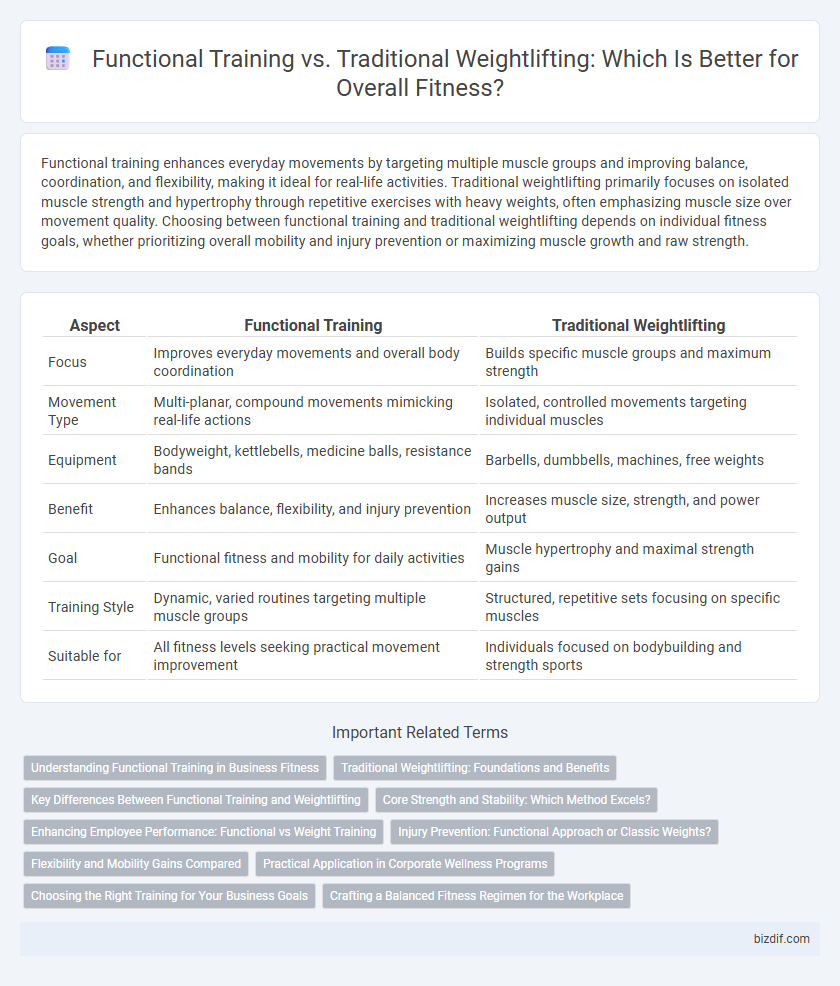Functional training enhances everyday movements by targeting multiple muscle groups and improving balance, coordination, and flexibility, making it ideal for real-life activities. Traditional weightlifting primarily focuses on isolated muscle strength and hypertrophy through repetitive exercises with heavy weights, often emphasizing muscle size over movement quality. Choosing between functional training and traditional weightlifting depends on individual fitness goals, whether prioritizing overall mobility and injury prevention or maximizing muscle growth and raw strength.
Table of Comparison
| Aspect | Functional Training | Traditional Weightlifting |
|---|---|---|
| Focus | Improves everyday movements and overall body coordination | Builds specific muscle groups and maximum strength |
| Movement Type | Multi-planar, compound movements mimicking real-life actions | Isolated, controlled movements targeting individual muscles |
| Equipment | Bodyweight, kettlebells, medicine balls, resistance bands | Barbells, dumbbells, machines, free weights |
| Benefit | Enhances balance, flexibility, and injury prevention | Increases muscle size, strength, and power output |
| Goal | Functional fitness and mobility for daily activities | Muscle hypertrophy and maximal strength gains |
| Training Style | Dynamic, varied routines targeting multiple muscle groups | Structured, repetitive sets focusing on specific muscles |
| Suitable for | All fitness levels seeking practical movement improvement | Individuals focused on bodybuilding and strength sports |
Understanding Functional Training in Business Fitness
Functional training enhances business fitness programs by emphasizing multi-joint, compound movements that mimic everyday activities, improving overall strength, balance, and coordination. Unlike traditional weightlifting which isolates specific muscles for hypertrophy and maximal strength gains, functional training promotes injury prevention and boosts workplace productivity through functional movement patterns. Implementing functional training in corporate wellness strategies supports employees' real-world physical demands, reducing absenteeism and healthcare costs.
Traditional Weightlifting: Foundations and Benefits
Traditional weightlifting emphasizes structured, progressive resistance exercises targeting specific muscle groups to build strength, muscle mass, and bone density. It relies on compound and isolation movements such as squats, deadlifts, and bench presses, promoting muscular hypertrophy and improved metabolic rate. Consistent practice enhances physical endurance, posture, and overall functional capacity, supporting long-term health and athletic performance.
Key Differences Between Functional Training and Weightlifting
Functional training emphasizes multi-joint movements that mimic real-life activities, improving overall strength, coordination, and balance, whereas traditional weightlifting focuses on isolated muscle groups to increase muscle size and maximal strength. Functional exercises often incorporate bodyweight, kettlebells, and resistance bands to enhance mobility and stability, while weightlifting typically uses barbells and machines targeting specific muscle hypertrophy and power. The key difference lies in functional training's holistic approach to movement efficiency versus weightlifting's emphasis on controlled, incremental load progression for muscle development.
Core Strength and Stability: Which Method Excels?
Functional training enhances core strength and stability by mimicking real-life movements that engage multiple muscle groups simultaneously, improving balance and coordination. Traditional weightlifting primarily targets isolated muscle groups, which can build strength but often lacks the dynamic stability benefits essential for everyday activities. Scientific studies indicate functional training provides superior improvements in core activation and overall postural control compared to conventional weightlifting routines.
Enhancing Employee Performance: Functional vs Weight Training
Functional training improves employee performance by targeting movement patterns used in daily tasks, enhancing core stability and mobility crucial for workplace efficiency. Traditional weightlifting primarily builds muscle strength and hypertrophy, which may not directly translate to practical job functions. Incorporating functional exercises fosters better balance, coordination, and injury prevention, leading to sustained productivity and reduced absenteeism in the workforce.
Injury Prevention: Functional Approach or Classic Weights?
Functional training emphasizes multi-directional movements and core stability, enhancing joint resilience and reducing injury risk by mimicking real-life activities. Traditional weightlifting builds muscular strength through isolated exercises but may increase injury risk if performed with poor form or excessive load. Combining functional exercises with proper weightlifting techniques offers a balanced approach to injury prevention and overall fitness development.
Flexibility and Mobility Gains Compared
Functional training emphasizes dynamic, multi-joint movements that enhance flexibility and mobility by mimicking everyday activities and improving range of motion. Traditional weightlifting primarily targets muscle strength and hypertrophy, often focusing on isolated movements that may limit joint mobility improvements. Studies indicate functional training results in greater gains in overall flexibility and joint stability compared to traditional weightlifting routines.
Practical Application in Corporate Wellness Programs
Functional training enhances corporate wellness by improving employees' mobility, balance, and core strength, which directly reduces workplace injuries and boosts overall productivity. Traditional weightlifting builds muscle mass and strength but may lack the movement-specific benefits crucial for daily office tasks and ergonomic demands. Incorporating functional exercises into wellness programs creates practical fitness that supports job-related activities and long-term health outcomes.
Choosing the Right Training for Your Business Goals
Functional training enhances real-world movement patterns by targeting multiple muscle groups simultaneously, improving balance, coordination, and flexibility, which benefits clients seeking overall fitness and injury prevention. Traditional weightlifting focuses on isolating specific muscles to build strength and muscle mass, ideal for clients aiming for hypertrophy and maximal strength gains. Selecting the right training depends on your business goals: prioritize functional training to attract clients interested in holistic fitness and athletic performance or traditional weightlifting to serve those focused on bodybuilding and strength development.
Crafting a Balanced Fitness Regimen for the Workplace
Functional training enhances workplace performance by improving movement patterns, stability, and core strength through dynamic exercises that mimic daily activities. Traditional weightlifting builds muscle mass and strength using isolated lifts, which can complement functional training by addressing specific muscular imbalances. Combining both approaches creates a balanced fitness regimen that supports posture, reduces injury risk, and boosts overall physical capacity for workplace tasks.
Functional Training vs Traditional Weightlifting Infographic

 bizdif.com
bizdif.com